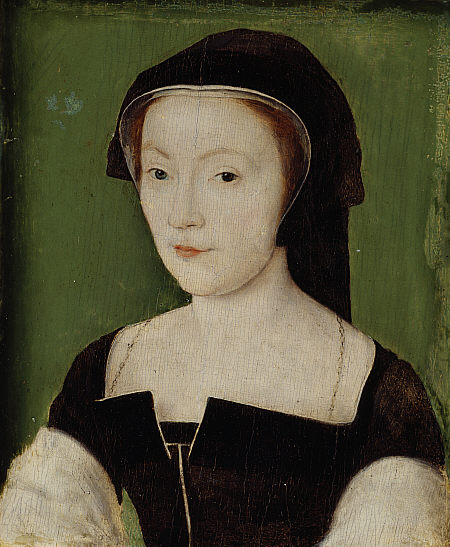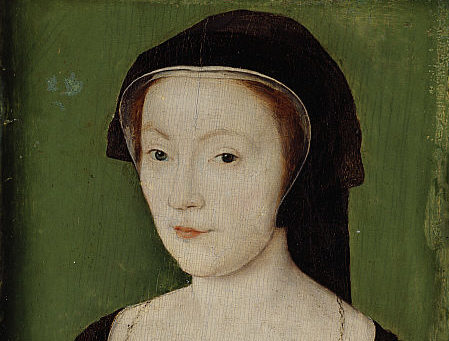
Marie de Guise was a member of the powerful House of Guise – a family that played a major role in 16th Century France.
Marie was married at 18 to Louis II d’Orleans, the Duke of Longueville, then widowed three years later in 1537. The timing led her to become the focus of marriage negotiations with Scotland since its King, James V, had recently lost his wife (Madeleine de Valois, the fifth child and third daughter of Francis I of France). James wanted another French bride to continue and strengthen the Auld Alliance but with no more princesses available, the next best option was marriage into the semi-regal Guise family.
Francis I clearly promoted this option: he announced that he would pay a princess-sized dowry for her. This made her a much-courted bride: even Henry VIII sued for her hand (his wife Jane Seymour had just died). These plans and offers were not terribly welcome to the 22-year old widow, who had hoped to be given a little more time to come to mourn a husband that she truly loved, and who hated the idea of leaving her beloved country. Still, given Henry’s marital history and Scotland’s traditional role as a friendly nation (to say nothing of the fact that James was a ruggedly handsome 26 while Henry was 46, fully bald and already tending to fat), James was obviously the preferable outcome.
Marie impressed her new mother-in-law (Henry VIII’s sister Margaret), the nobility, the entire country. She quickly bore her husband two sons – both of whom unfortunately died before they were a year old. She had a third child, Mary, born December 8, 1542. Unfortunately, Margaret Tudor’s death the year before had removed the only pro-English voice left at court, which led to war between Scotland and England. James spent several months with his army, took sick several times. He died of a fever on December 14, shortly after a serious defeat at the Battle of Solway Moss, leaving his six-day-old daughter Queen of Scotland.
James Hamilton, the Second Earl of Arran and the most powerful man in the realm, became Regent for the young Queen, though Marie de Guise remained a powerful political player. In 1554, she took over as regent for her daughter, then eleven years old and living in France with her fiance, the Dauphin Francis. Under Marie’s regency, Scotland was completely pro-French, with many top government posts held by Frenchmen. Scotland was also adamantly Catholic. This created bad feelings with England when Elizabeth I mounted the throne. Under Henry VIII’s will, his niece Mary of Scotland was the next rightful heir – but to Catholic rulers, Elizabeth was an illegitimate usurper and Mary already the true queen. When Mary and Francis came to the French throne in 1559, the couple exacerbated the issue by adding the arms of England to their blazon. It was a move Mary was to regret later in life.
Marie lived to see her daughter become Queen of France, and she was spared seeing that same daughter widowed in December 1560: Marie had fallen seriously ill earlier in the year, and died of dropsy on June 11th. Her body was secreted out of the country so that she could be buried in France, in the Convent of Saint-Pierre. Mary attended the funeral.
***
If you like my posts, you’ll love my books! My Seymour Saga trilogy tells the gripping story of the short-lived dynasty that shaped the Tudor Era. Jane the Quene skews romantic, The Path to Somerset is pure Game of Thrones (without the dragons), and The Boy King is a noir coming-of-age. Get them now through Amazon, Barnes & Noble, Kobo, and Apple, or even your local independent bookstore!

(PS Already read them? Did you love them? Then please review them – even just a stars rating! It makes a huge difference in helping new readers find them and would mean the world to me!)

Isn’t she the one who reportedly said something about although a tall (large) woman, she had a very little neck to Henry VIII’s emissaries?
She also wasn’t the only one to allude to the fate of Henry’s brides – Cristina of Denmark reportedly said “If I had two heads, one should be at the King of England’s disposal”
She was indeed!